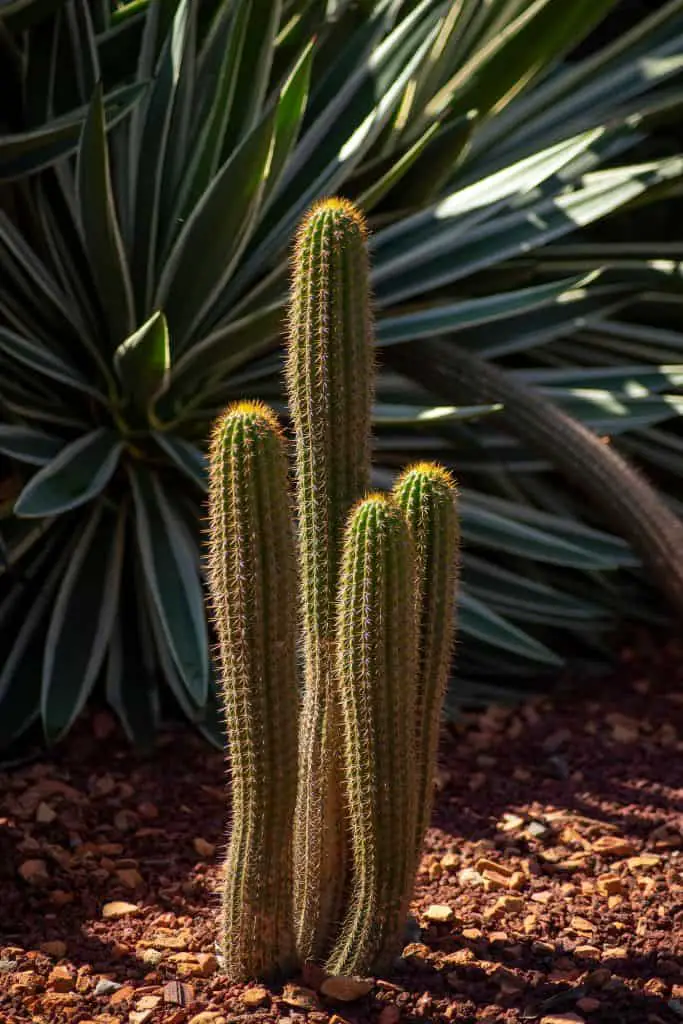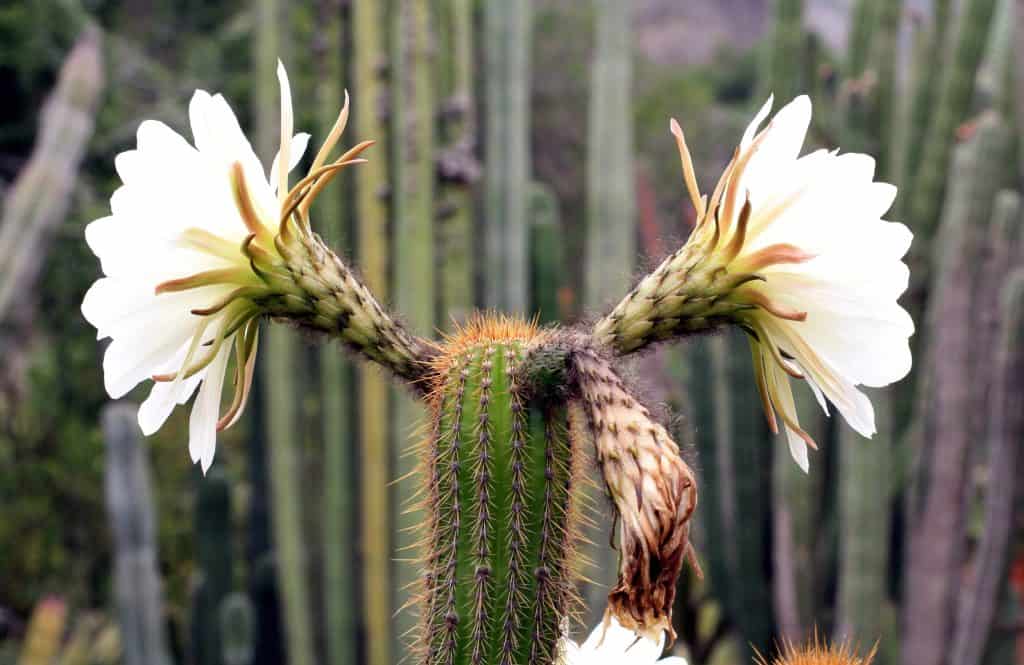| Common Name(s) | Golden torch, golden column cactus, and sea urchin cactus. |
| Scientific Name | Echinopsis spachiana previously Trichocereus spachianus |
| Sun Exposure | Full direct |
| Soil pH | Neutral to acidic |
| Watering Requirement | Every 10 days to 2 weeks |
| Hardiness Zone | 9-11 USDA |
| Plant Height | 6ft |
| Plant Width | 6-8 inches |
Golden Torch Cactus stretches tall and long with a glorious batch of golden yellow spikes on its crown. It has sturdy ribs that run vertically around its medium green colored body. Golden Torch Cactus branches grow from the base of the cactus in the same direction as the main stem.
They are often planted in xeriscape landscaping schemes and rock gardens. Some of their best planting mates are cacti agaves and blooming desert shrubs. Whether you have a structured landscape design or a more natural free forming garden Golden Torch Cactus seems to fit most aesthetics
Its botanical name is Echinopsis spachiana, and it was previously known as Trichocereus spachianus. Other common names for Golden Torch Cactus are Golden torch, golden column cactus, and sea urchin cactus.

Golden Torch Cactus Care
Similar to a majority of cacti, Golden Torch Cactus is very easy to care for. The most important thing to remember is not to overwater it. They are drought resistant and are able to store up water inside themselves during rainfalls to sustain themselves.
Golden Torch Cactus Size
Golden Torch Cactus can grow to be 6 ft tall and 6-8 inches in diameter. They also have a generous amount of branches that grow from the base of the plant and can add a substantial amount of width.
Golden Torch Cactus Growth Rate
You can expect a growth rate of about 6 inches per year for your Golden Torch Cactus. Because of this slow growth rate, Golden Torch Cactus can be an excellent decorative plant in a pot on patios and porches.
If you’re on pins and needles waiting for your Golden Torch Cactus to bloom this will not happen until year 3 or 4.
Lighting Requirement
Full direct sunlight is best for your Golden Torch Cactus to bask in. If your cactus is usually inside feel free to move it outdoors in the summertime so all sides of it can be flooded with light. This will make a very happy cactus for you.
Soil Type and pH Requirement
Cacti require well-draining soil. Golden Torch Cactus can be potted in a ready mixed, store bought cactus mix successfully. If planting Golden Torch Cactus as part of an outdoor landscape, make sure the soil is sandy and will not hold water. Cactus roots are very susceptible to root rot.
Golden Torch Cactus is not picky about pH and will thrive in neutral to acidic soil.
Watering Requirement
If your Golden Torch Cactus is potted water them every 10 days to 2 weeks as needed. Be sure not to overwater your cactus. The Soil should be dry without being hard when you give your Golden Torch Cactus a drink. If outdoors watch for dry soil and pay attention to the last time it rained. Golden Torch Cactus can store rainwater for quite a while, but if it’s been a while since the last rainfall in your area and the ground soil is dry go ahead and water your Golden Torch Cactus.

Temperature Requirement
Temperatures above 70F are ideal for Golden Torch Cactus. They can withstand temperatures as low as 14F in colder months.
Golden Torch Cactus Hardiness Zone
Golden Torch Cactus is best suited for a hardiness zone of 9-11 USDA.
Fertilization Requirement
Fertilize Golden Torch once in the spring and once in the midsummer. The first fertilization should occur as the plant is coming out of its dormancy and then midseason in the summer while it is having a growth spurt. You can use a commercial cactus fertilizer or a houseplant fertilizer. Follow the directions on the package.
Golden Torch Cactus Propagation
There will be a liberal amount of off-shooting branches that sprout from the base of Golden Torch Cactus. To propagate a Golden Torch Cactus first scout out an offshoot that is healthy and approximately 20-30 inches in length. Slice your chosen cactus limb at the thinnest spot where it attaches to the parent plant.
Cover the shaft of the cut cactus leaving the cut end exposed and place it in direct sunlight to dry. This is also known as callousing. Once the end has been calloused over, this can take anywhere from a few days to a couple of weeks, place the Golden Torch Cactus in a rooting medium.
It’s critical to keep the cut end of the cactus damp and lukewarm until roots appear.
When roots appear your new Golden Torch Cactus can be planted in cactus soil and will be viable and well. At this point, you can start caring for your new Golden Torch Cactus as usual.
Seeds can also be saved from the fruit of the Golden Torch Cactus, but this is a much more lengthy process.
Common Problems with Golden Torch Cactus
Mealybugs are the most common pest that affects Golden Torch Cactus. To identify if your cactus has mealybugs look for misshapen leaves, yellowing, and diminished growth. Mealybugs are a scale pest and they suck the juices out of the plant.
To remedy a mealybug infestation you can use simple tactics with items you probably have in your home already.
Isopropyl alcohol is an effective and simple remedy. If the invasion is relatively small you can dip a cotton swap in the alcohol and swipe it over the affected scale area.
If the infestation is on the larger side you may want to use a spray bottle to administer the alcohol to the entire cactus.
Red Spider mites are another potential pest to look out for. Spider mites are quite dangerous to Golden Torch Cactus. They tend to show up when the weather is cooler. If you notice your plants have a fine dust on them and look generally unhealthy this is a good indication they have red spider mites.
The best solution is to bring in reinforcements in the form of ladybugs and have them take care of the problem for you.
Root rot can be a problem for your Golden Torch Cactus if it has been overwatered. The best cure for root rot is prevention. Only water your Golden Torch Cactus when the soil is dry and be sure it drains well.
If you are experiencing root rot, your cactus may have black spots on the skin surface, squishy parts especially around the bottom, and sunken spots.
It is very difficult to heal Golden Torch Cactus from root rot. Often the best case scenario is to cut off an offshoot or two and propagate new cacti.
Drooping is an early sign of overwatering
Shriveling and dried-out skin indicates your Golden Torch Cactus needs more water.
If your Golden Torch Cactus is looking spindly or discolored it needs more light.
Burning or scarring means your Golden Torch Cactus needs less direct harsh light.
Golden Torch Cactus Flower
Golden Torch Cactus is a blooming cactus. The flower of the Golden Torch Cactus is irresistible. When it blooms the blossom is breathtaking with its large white petals. The flowers are 5-8 inches long and tubular. Usually, multiple flowers bloom at once making the display even more amazing to behold. The scent of Golden Torch Cactus flowers is what really steals the show. The aroma is very perfumy to human nostrils.
How often does it bloom?
Golden Torch Cactus blooms up to 3 times a year. Most commonly it blooms in spring and summer, and it has been known to sometimes bloom in the fall as well.
How to get it to bloom?
Blooms will start in the third or fourth year for Golden Torch Cactus. In the summer put your cactus outside to get all of the benefits of sunny hot weather and direct light. Then bring it inside in a semi-dark room in the winter. Repeat those steps faithfully and your Golden Torch Cactus should bloom in due time.
Golden Torch Cactus fruit
If you can get your hands on some Golden Torch Cactus fruit you are in possession of a delicacy. The fruit grows on the side of the cactus after the white blossoms have been pollinated. When they split that means they are ripe and ready for harvest.
They generally aren’t used in any prepared recipes and are eaten as is after removing the thick outer protective layer. The inside is cottony and white with black seeds. The flesh and seeds can be consumed. The sweetest fruit is the fruit with a dry texture, not the plumper glossy ones.
Is Golden Torch Cactus a Psychedelic?
There are trace amounts of mescaline and tyramine in Golden Torch Cactus. You would have to ingest a large amount to start tripping.
Where can I Find Golden Torch Cactus for sale?
You can purchase Golden Torch Cactus online or in specialty brick and mortar plant shops. Price is dependent on the size of the Golden Torch Cactus and ranges from USD 15 to USD 110.
